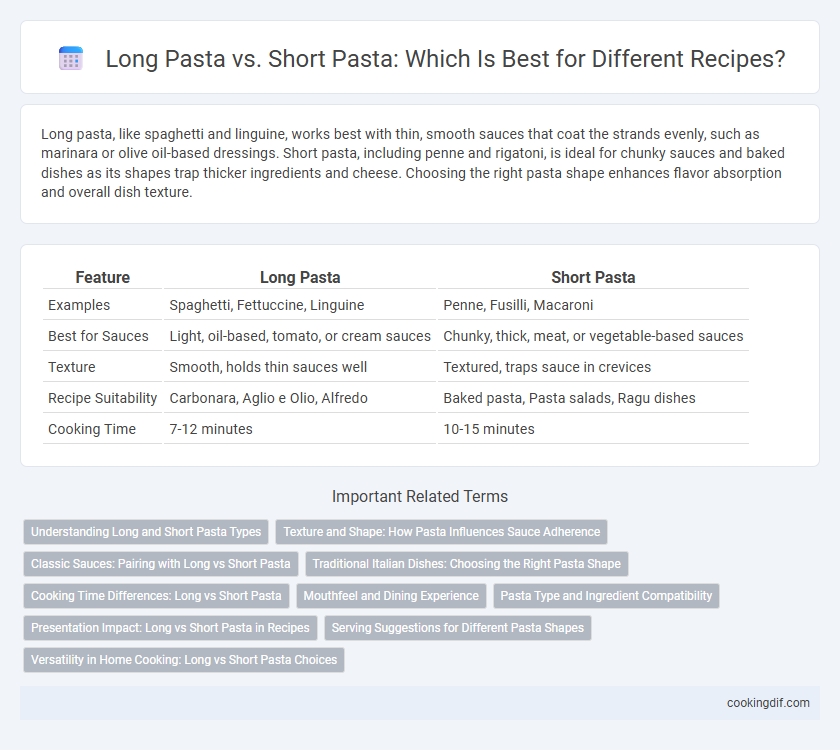Long pasta, like spaghetti and linguine, works best with thin, smooth sauces that coat the strands evenly, such as marinara or olive oil-based dressings. Short pasta, including penne and rigatoni, is ideal for chunky sauces and baked dishes as its shapes trap thicker ingredients and cheese. Choosing the right pasta shape enhances flavor absorption and overall dish texture.
Table of Comparison
| Feature | Long Pasta | Short Pasta |
|---|---|---|
| Examples | Spaghetti, Fettuccine, Linguine | Penne, Fusilli, Macaroni |
| Best for Sauces | Light, oil-based, tomato, or cream sauces | Chunky, thick, meat, or vegetable-based sauces |
| Texture | Smooth, holds thin sauces well | Textured, traps sauce in crevices |
| Recipe Suitability | Carbonara, Aglio e Olio, Alfredo | Baked pasta, Pasta salads, Ragu dishes |
| Cooking Time | 7-12 minutes | 10-15 minutes |
Understanding Long and Short Pasta Types
Long pasta varieties such as spaghetti, linguine, and fettuccine are ideal for light, oil-based or creamy sauces that cling to their strands, enhancing flavor absorption and texture. Short pasta shapes like penne, rigatoni, and fusilli work best with chunky or meat-based sauces, as their hollow or ridged surfaces trap ingredients, creating a hearty bite. Selecting the appropriate pasta type ensures optimal sauce adherence and balanced taste in any recipe.
Texture and Shape: How Pasta Influences Sauce Adherence
Long pasta varieties like spaghetti and fettuccine offer smooth surfaces and slender shapes that best suit thin, oil-based, or cream sauces, allowing even coating without overwhelming the strands. Short pasta, such as penne and fusilli, have ridges and hollow centers that trap chunky or thick sauces, enhancing flavor retention and texture contrast in each bite. The shape and texture of pasta directly influence sauce adherence by balancing coverage, sauce absorption, and mouthfeel, thus determining recipe compatibility.
Classic Sauces: Pairing with Long vs Short Pasta
Long pasta shapes like spaghetti and linguine excel with classic sauces such as marinara, Alfredo, and aglio e olio because their slender strands evenly coat and hold lighter, smoother sauces. Short pasta varieties like penne, rigatoni, and fusilli are ideal for chunkier, meat-based sauces like Bolognese or arrabbiata, as their grooves and tubular shapes trap rich, textured ingredients. Choosing the right pasta shape enhances flavor absorption and texture balance, ensuring a harmonious dish with traditional Italian sauces.
Traditional Italian Dishes: Choosing the Right Pasta Shape
Long pasta like spaghetti and fettuccine excels in traditional Italian dishes with smooth or light sauces such as aglio e olio or carbonara, allowing the noodles to evenly coat each strand. Short pasta varieties like penne, rigatoni, and farfalle are ideal for chunky sauces, baked dishes, or hearty ragus, as their shapes trap bits of meat, vegetables, and sauce for balanced flavor in each bite. Selecting the appropriate pasta shape enhances texture harmony and authentic taste in regional Italian recipes.
Cooking Time Differences: Long vs Short Pasta
Long pasta varieties like spaghetti and linguine generally require longer cooking times, typically ranging from 8 to 12 minutes, compared to short pasta types such as penne or fusilli, which cook in about 6 to 9 minutes. The thickness and shape of long pasta contribute to a more gradual heat penetration, affecting texture and al dente firmness. Short pasta's compact form allows for quicker boiling and absorption of sauce, making it ideal for speedier meal preparation.
Mouthfeel and Dining Experience
Long pasta varieties like spaghetti and linguine provide a smooth, continuous mouthfeel that enhances sauces with lighter textures, creating a refined dining experience. Short pasta shapes such as penne and fusilli capture chunkier sauces in their crevices, offering a textured bite that intensifies flavor complexity. Selecting pasta length based on sauce consistency and desired mouthfeel elevates overall meal enjoyment.
Pasta Type and Ingredient Compatibility
Long pasta such as spaghetti or fettuccine pairs best with light, smooth sauces like olive oil-based or creamy sauces, allowing the strands to hold the flavors evenly. Short pasta types like penne or rigatoni are ideal for thicker, chunkier sauces and ingredients such as meat, vegetables, or cheese, as their shapes trap and hold sauce effectively. Ingredient compatibility is key: delicate seafood or pesto suits long pasta, while hearty ragu or vegetable medleys complement short pasta varieties.
Presentation Impact: Long vs Short Pasta in Recipes
Long pasta varieties like spaghetti and linguine create visually striking, elegant presentations that emphasize length and texture, ideal for saucier dishes where the pasta's shape enhances sauce cling. Short pasta, such as penne or fusilli, offers a more structured and hearty appearance, making it suitable for baked dishes and chunky sauces where the pasta's ridges or tubes capture ingredients effectively. The choice between long and short pasta directly influences the overall dish presentation, impacting plating style and aesthetic appeal in culinary creations.
Serving Suggestions for Different Pasta Shapes
Long pasta varieties such as spaghetti and linguine are ideal for light sauces like olive oil, garlic, or seafood-based recipes, as their slender shape allows the sauce to cling evenly. Short pasta shapes like penne, rigatoni, and fusilli work best with chunkier, heartier sauces including meat ragu, vegetable mixtures, or baked dishes due to their grooves and hollow centers that trap sauce effectively. Choosing the right pasta shape enhances the overall flavor balance and texture, making dishes like spaghetti aglio e olio or baked ziti more satisfying and tailored to their specific sauce profiles.
Versatility in Home Cooking: Long vs Short Pasta Choices
Long pasta like spaghetti and fettuccine excels in recipes with light, smooth sauces such as olive oil or tomato-based ones, providing a delicate texture that easily twirls on a fork. Short pasta varieties such as penne and rigatoni offer better sauce retention due to their ridges and hollow shapes, making them ideal for chunky, hearty sauces and baked dishes. The choice between long and short pasta ultimately depends on the sauce texture and desired eating experience in home cooking.
Long pasta vs short pasta for recipe suitability Infographic

 cookingdif.com
cookingdif.com